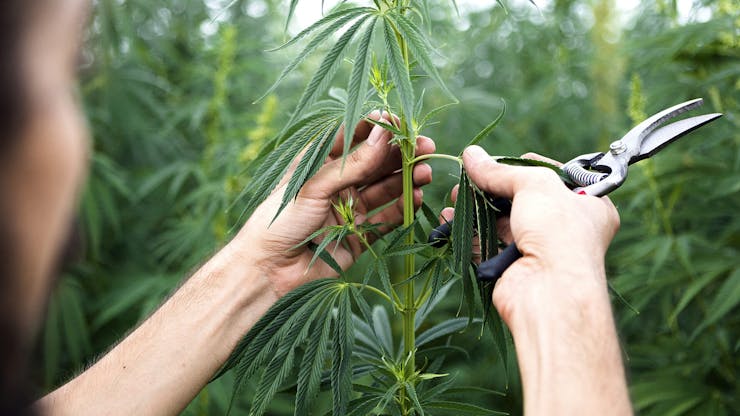On Monday, sheriff’s deputies in Rutherford County, Tennessee, launched a series of coordinated raids across the district, a diverse and populous area in the state’s geographic center.
CBD is found in marijuana, a plant that’s banned at the federal level. But CBD is also found in industrial hemp—a plant that Americans can legally cultivate.
The triggering incidents, Sheriff Mike Fitzhugh later told reporters, was a child bringing home a piece of candy that contained CBD, or cannabidiol—a nonintoxicating compound present in the cannabis plant—and the resulting call to authorities from the child’s incensed parents.
But prior to December 7, 2016, neither Fitzhugh nor federal Drug Enforcement Administration agents would have been able to do anything about it.
CBD is found in marijuana, a plant listed in Schedule I of the Controlled Substances Act and thus banned coast to coast. But CBD is also found in industrial hemp—a plant that Americans can legally cultivate under the 2014 Farm Bill, and that Americans have always been able to import and use in the manufacture of soap, fiber, and other popular products.
Botanically speaking, there’s not a shred of difference between the two plants: Both are cannabis Sativa under the Linnean definition. Legally speaking, the two do indeed have a binary difference: One is federally legal, and the other is not. Under federal law, “hemp” is defined as cannabis Sativa plants with less than 0.3 percent THC. Anything with more is “marijuana.”
Along with its sexier and more lucrative recreational marijuana industry, America also has a nascent industrial hemp industry, worth possibly half a billion dollars, compared to the $7 billion California’s marijuana industry is worth alone. The major difference is that there’s potential for a hemp industry in 50 states—or at least there was, prior to the DEA’s December 2016 decision that CBD, and any other “cannabis extract” that also contains a single cannabinoid, is absolutely marijuana and thus subject to enforcement.
Under federal law, “hemp” is defined as cannabis Sativa plants with less than 0.3 percent THC. Anything with more is “marijuana.”
Hence Monday’s operation. By the time “Operation Candy Crush” was through, 23 stores alleged to have sold CBD-laced candies were shut down as “public nuisances,” according to prosecutors, and 21 people were arrested. They’ll face indictments in state court that will be unsealed Friday.
The situation in Tennessee provided a timely and relevant backdrop for a hearing in federal court taking place a few thousand miles away in San Francisco. On Thursday, the US Ninth Circuit Court of Appeals heard oral arguments in Hemp Industries Association vs. DEA, a lawsuit challenging the DEA’s December 2016 decision lumping in CBD and any other cannabinoid extract into its definition of “marijuana.”
Judges will now weigh whether to strike the DEA’s ruling regarding CBD. And they may also decide the central questions at issue in Tennessee and other states where state and federal authorities are seizing hemp or CBD products, citing the DEA ruling: Is “cannabis” marijuana? And is “cannabis” banned under federal law?
After hearing oral arguments Thursday, a decision could come anytime in the next three to nine months. The potential ramifications for the country’s hemp industry—as well as sick people in states that allow CBD, but not THC—are enormous. And there is very little evidence to guess how they will decide, aside from the questions asked in court Thursday.
For Bob Hoban, the hemp association’s Denver-based attorney, the law “is very clear,” he told a three-judge panel Thursday. “Cannabis is not a controlled substance,” and the DEA clearly overstepped its authority in adding cannabis extracts, and specifically CBD, to its list of banned substances without an act of Congress.
By declaring CBD banned while also allowing hemp cultivation under the farm bill, two branches of the federal government are giving conflicting advice.
To support this, Hoban has case law on his side, thanks to the Ninth Circuit.
In 2004, in a case now known as Hemp II, judges ruled that the DEA had no authority to regulate drugs that were not explicity scheduled—and that “parts of the plant are exempt” from the definition of marijuana and thus the CSA, Hoban told Leafly.
Since it was the DEA who clarified their definition of marijuana to include CBD, and not Congress adding to the CSA to include CBD, “this would cover that,” he said. Further, by declaring CBD banned while also allowing hemp cultivation under the farm bill, two branches of the federal government are giving conflicting advice. One is saying hemp is legal—the other is saying it’s not.
In making its case in 2016 and again in court on Thursday, the DEA cited both existing federal law and a pair of United Nations treaties, to which the US is a signatory: the 1961 Single Convention on Narcotic Drugs and the 1971 Convention on Psychotropic Substances. To comply with the US’s obligations to the treaty, which declares marijuana dangerous and banned, the definition must be updated to include a marijuana-like product such as CBD.
Judges questioned whether the treaties also give the DEA leeway to expand its definition of marijuana.
The DEA “can do that, but that’s not what they did,” Hoban told Leafly. “It’s within their purview, but they did not follow the proper procedure. And I think they [the judges] got that.”
Thursday’s hearing drew a slew of attorneys from across the country as well as hemp industry figures. Opinion was split as to how the hearing went. “That was rough,” one said, finding an ill omen in the judges’ references to the UN treaties.
Hoban was sanguine. “They didn’t challenge that the genus ‘cannabis’ is not illegal,” he said. “And they didn’t challenge that cannabinoids are not controlled substances.”
Which means one of two things: They accepted Hoban’s argument, “or they completely disagreed,” he said.





